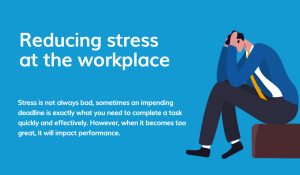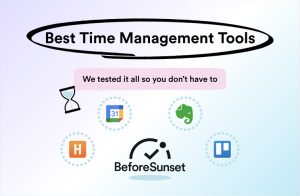
by admin | Mar 5, 2024 | Study, Skills Gap Analysis
How to Reduce Stress at Work: Strategies for a Calmer Professional Life

In today’s fast-paced work environment, stress has become a common companion for many professionals. High levels of stress not only affect your productivity and job satisfaction but can also have serious implications on your health and well-being. Fortunately, there are effective strategies to manage and reduce stress at work. This blog explores practical steps you can take to create a more serene and enjoyable work experience.
1. Prioritize and Organize
One of the primary sources of work stress is the feeling of being overwhelmed by tasks. Prioritize your work by distinguishing between urgent and important tasks. Utilize tools and techniques such as to-do lists, digital planners, or the Eisenhower Box to manage your tasks more effectively. Organizing your work can significantly reduce stress by making your workload more manageable.
2.Set Realistic Goals
Setting achievable goals within realistic timeframes is crucial. Unrealistic expectations can lead to disappointment and increased stress. Break down larger projects into smaller, manageable tasks, and set clear milestones. Celebrate small achievements along the way to stay motivated.
3. Take Regular Breaks
Continuous work without breaks can lead to burnout and stress. Short, frequent breaks throughout the day can help clear your mind and improve focus. Techniques like the Pomodoro Technique, which involves working for 25 minutes followed by a 5-minute break, can enhance productivity while reducing stress.
4. Learn to Say No
Taking on more work than you can handle is a surefire way to increase stress. Learn to say no or delegate tasks when your plate is full. Being honest about your capacity for work will help maintain your mental health and ensure the quality of your work remains high.
5. Develop Healthy Responses
Instead of coping with stress through unhealthy habits like smoking or overeating, find healthier ways to manage stress. Exercise, meditation, and hobbies can be effective outlets. Activities such as yoga and mindfulness exercises can also help reduce stress levels significantly.
6. Establish Boundaries
In today’s digital world, it’s easy to feel like you’re always “on.” Establish clear boundaries between work and personal time. This might mean turning off email notifications after work hours or setting specific times when you are not available for work-related queries. Respecting these boundaries is crucial for stress reduction.
7. Improve Communication Skills
Effective communication can resolve many work-related stresses. Expressing your thoughts and concerns clearly, listening to others, and engaging in constructive feedback can improve your work relationships and reduce misunderstandings and conflicts.
8. Seek Support
Whether it’s from colleagues, friends, family, or mental health professionals, support is vital. Sharing your experiences and challenges can provide relief and offer new perspectives on managing stress. Many employers also offer wellness programs or counseling services as part of their benefits package.
9.Optimize Your Workspace
A cluttered, uncomfortable workspace can contribute to stress. Make your work area a pleasant, organized space. Personal touches like plants, photos, or ergonomic furniture can make a significant difference in your comfort and stress levels.
10. Practice Gratitude
Focusing on positive aspects of your work and life can shift your perspective on stress. Practicing gratitude by acknowledging things you’re thankful for in your professional life can foster a positive work environment and reduce stress.
Conclusion
While stress at work is common, it doesn’t have to be a defining feature of your professional life. By implementing these strategies, you can manage stress more effectively and create a healthier, more enjoyable work environment. Remember, taking care of your mental health is just as important as meeting deadlines and achieving professional success.

by admin | Mar 4, 2024 | Study, Skills Gap Analysis

Time Management Apps and Tools: Enhance Your Productivity with Technology
In today’s fast-paced world, managing our time effectively has become more critical than ever. Fortunately, with the help of technology, there is a wide range of time management apps and tools available to assist us in organizing our tasks, prioritizing our activities, and maximizing our productivity. In this blog post, we’ll review some popular time management apps and tools on the market, highlighting their features and how they can help users better organize their time and tasks.
1. Todoist
Features:
– Todoist is a powerful task management app that allows users to create and organize tasks, set deadlines and priorities, and collaborate with team members.
– It offers various features such as project organization, recurring tasks, labels, and filters, making it easy to manage both personal and professional tasks.
– Todoist also integrates with popular productivity tools like Google Calendar, Dropbox, and Slack, providing seamless connectivity and workflow automation.
How it Enhances Productivity:
– Todoist’s intuitive interface and customizable features help users stay organized and focused on their goals, reducing overwhelm and procrastination.
– With its cross-platform availability and real-time sync, users can access their tasks and projects from anywhere, ensuring that nothing falls through the cracks.
– The app’s gamification elements, such as Karma points and productivity trends, motivate users to stay productive and maintain consistency in completing tasks.
2. Trello
Features:
– Trello is a visual collaboration tool that uses boards, lists, and cards to organize and prioritize tasks and projects.
– Users can create boards for different projects or workflows, add cards for individual tasks, and move cards across lists to track progress.
– Trello offers features like due dates, checklists, attachments, and comments, facilitating effective communication and task management within teams.
How it Enhances Productivity:
– Trello’s visual interface provides users with a clear overview of their tasks and projects, making it easier to prioritize and allocate time effectively.
– The app’s customizable workflows and automation capabilities enable users to streamline their processes and reduce manual effort, increasing efficiency.
– Trello’s integration with third-party apps like Google Drive, Slack, and Dropbox allows for seamless collaboration and information sharing, enhancing productivity across teams.
3. Forest
Features:
– Forest is a unique productivity app that helps users stay focused and avoid distractions by gamifying the Pomodoro Technique.
– Users plant virtual trees when they start a focused work session, and the tree grows while they remain focused. If they leave the app, the tree dies.
– Over time, users can grow a forest of trees representing their productive work sessions and track their progress over days, weeks, and months.
How it Enhances Productivity:
– Forest encourages users to stay focused and avoid distractions by rewarding them with a sense of accomplishment and a visually appealing virtual forest.
– The app’s gamification elements make the Pomodoro Technique more engaging and enjoyable, motivating users to maintain their focus and productivity.
– Forest also partners with real-world tree-planting organizations, so users can contribute to environmental causes while improving their time management skills.
Conclusion
Time management apps and tools offer valuable assistance in organizing our tasks, prioritizing our activities, and maximizing our productivity. Whether it’s managing tasks and projects with Todoist, visualizing workflows with Trello, or staying focused with Forest, there is a time management app or tool to suit every preference and workflow. By leveraging technology to enhance our time management skills, we can optimize our productivity, reduce stress, and achieve our goals more efficiently than ever before.

by admin | Dec 27, 2023 | Job, Study



Building a personal brand is essential for professional success in today’s competitive landscape. A strong personal brand can set you apart from others in your field, establish your expertise, and open doors to new opportunities. In this blog, we’ll explore key strategies and tips for building and maintaining an effective personal brand.
1. Identify Your Unique Value Proposition
The first step is to understand what makes you unique. This includes your skills, experiences, passions, and values. Ask yourself what you can offer that others in your field cannot. This unique value proposition will be the cornerstone of your personal brand.
2. Define Your Target Audience
Knowing your audience is crucial. Identify who you want to reach with your brand. Are they potential employers, clients, or collaborators in your industry? Understanding your audience will guide your branding efforts and help you tailor your message.
3. Craft Your Personal Story
People connect with stories. Create a compelling narrative about your journey, challenges, successes, and learnings. This story should be authentic and resonate with your target audience, reflecting both your professional path and personal insights.
4. Develop a Consistent Online Presence
In the digital age, your online presence is a significant part of your personal brand. Ensure that your LinkedIn profile, personal website, and social media accounts reflect your professional image consistently. Regularly update these platforms with relevant content and accomplishments.
5. Network Effectively
Building a strong network is key. Attend industry events, join professional groups, and participate in online forums. Networking isn’t just about meeting new people; it’s about building meaningful relationships and exchanging value.
6. Demonstrate Thought Leadership
Establish yourself as a thought leader in your field by sharing insights, writing articles or blog posts, and speaking at events. This showcases your expertise and contributes to the body of knowledge in your industry.
7. Seek Feedback and Evolve
Your personal brand should evolve as you grow professionally. Regularly seek feedback from mentors, colleagues, and your network. Use this feedback to refine your brand and stay relevant in your field.
8. Maintain Professionalism
Always exhibit professionalism in your interactions, both online and offline. Your behavior and communication should consistently reflect the values and image of your personal brand.
9. Be Authentic
Authenticity is key to a successful personal brand. Be true to yourself and your values. Authenticity fosters trust and builds stronger connections with your audience.
10. Give Back to Your Community
Contribute to your industry or community. This could be through mentoring, volunteering, or supporting causes related to your field. Giving back not only enriches your personal brand but also helps build a supportive professional community.
Conclusion
Building a personal brand is an ongoing process that requires reflection, consistency, and adaptation. By following these steps, you can develop a strong personal brand that aligns with your professional goals and resonates with your audience. Remember, your personal brand is a reflection of who you are and how you wish to be perceived in the professional world. Make it count!

by admin | Dec 26, 2023 | Job, Study
10 Tips for Writing an Outstanding Resume”
A well-crafted resume can significantly enhance your chances of landing the job you desire. Here are ten tips to help you create an outstanding resume that grabs the attention of hiring managers:
1. Start with a compelling summary: Begin your resume with a concise summary statement that highlights your key skills, experiences, and career goals. This section should entice employers to continue reading.
2. Tailor your resume to the job: Customize your resume for each position you apply for. Analyze the job description and align your skills and experiences with the specific requirements of the role.
3. Use a professional format: Ensure that your resume is well-structured and easy to read. Use clear headings, bullet points, and a professional font. Consider using a clean and modern resume template.
4. Highlight your accomplishments: Instead of simply listing your responsibilities, focus on showcasing your achievements. Quantify your accomplishments whenever possible to demonstrate your impact in previous roles.
5. Showcase relevant skills: Identify the key skills sought by the employer and highlight them prominently in your resume. Use specific examples to demonstrate how you have utilized these skills in previous roles.
6. Use action verbs: Start your bullet points with strong action verbs to describe your experiences and accomplishments. Words like “achieved,” “implemented,” or “managed” convey a sense of proactivity and accomplishment.
7. Include relevant keywords: Many employers use applicant tracking systems (ATS) to screen resumes. Incorporate relevant keywords from the job description to increase your chances of passing the initial screening process.
8. Keep it concise: Aim for a one to two-page resume, focusing on the most relevant information. Be selective and prioritize the experiences and skills that align with the job you’re applying for.
9. Proofread for errors: Thoroughly review your resume for any spelling, grammar, or formatting errors. A well-polished resume demonstrates attention to detail and professionalism.
10. Include contact information and a LinkedIn profile: Ensure that your resume includes your updated contact information, such as your phone number and professional email address. Additionally, provide a link to your LinkedIn profile, which can serve as a comprehensive online representation of your professional background.
Remember, your resume should be a compelling snapshot of your qualifications and experiences. Tailor it to each job application, emphasize your achievements, and ensure that it’s error-free and easy to read. By following these tips, you’ll be well on your way to creating an outstanding resume that captures the attention of employers.









